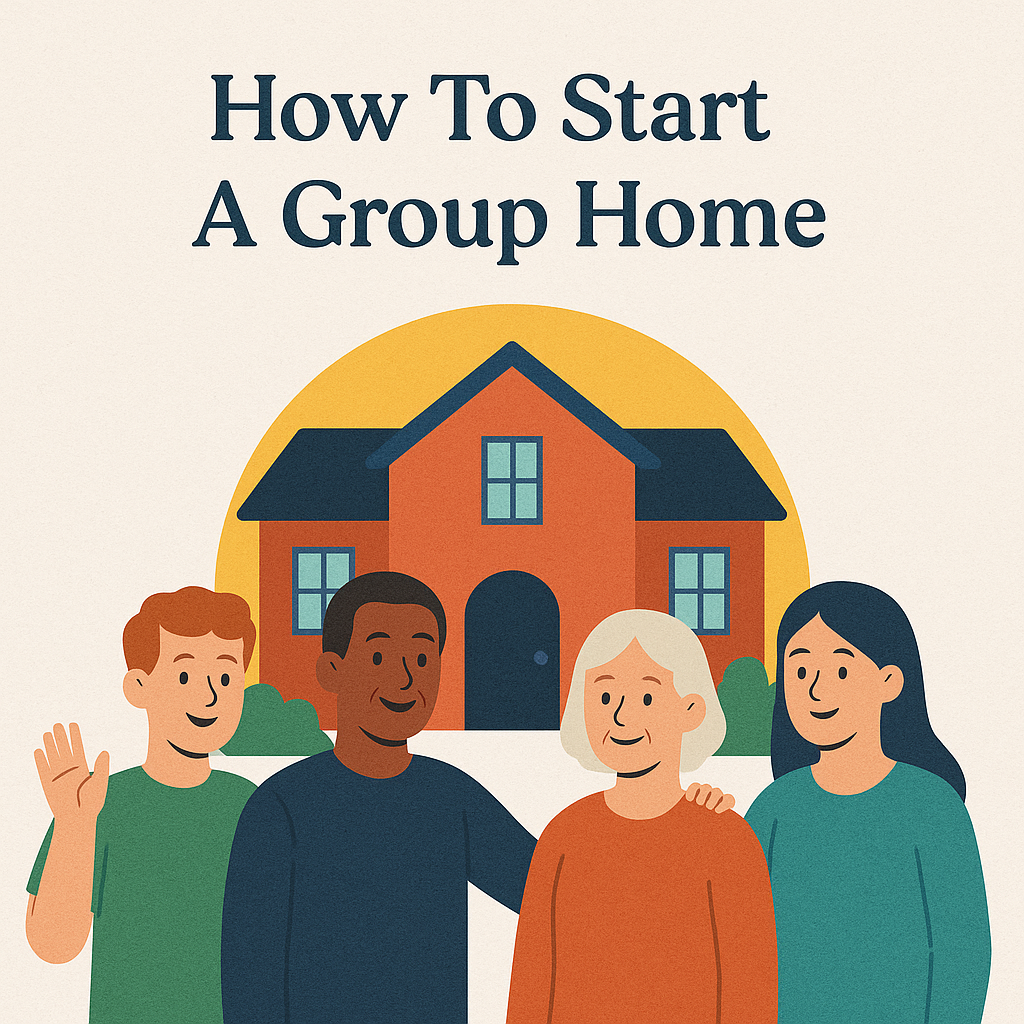Residential care facilities are becoming essential across the U.S., offering safe spaces for those needing specialized support. If you’re exploring ways to make a difference while building a purposeful venture, establishing a group home could align with your goals. This guide provides actionable insights for navigating this meaningful path.
The demand for compassionate care solutions continues to rise. From seniors to individuals with disabilities, many rely on structured environments to thrive. Creating such a space blends community service with sustainable operations—if approached thoughtfully.
Success begins with thorough preparation. Licensing rules, zoning laws, and safety standards vary by state, requiring careful research. You’ll also need strategies for securing funding, hiring trained staff, and designing programs that prioritize residents’ well-being.
This resource breaks down each phase of the journey. Learn about compliance checklists, budgeting templates, and tips for fostering an inclusive atmosphere. Whether you’re driven by personal passion or professional ambition, clarity and commitment remain vital.
By the end, you’ll understand how to transform your vision into a functional, impactful facility. Let’s begin!
Key Takeaways
- Residential care demand is rising, creating opportunities for new facilities.
- Detailed planning ensures compliance with state and local regulations.
- Licensing and staffing are critical operational foundations.
- Funding strategies must balance sustainability with quality care.
- A resident-focused environment drives long-term success.
Understanding Group Homes in the United States
Residential environments designed for vulnerable populations play a vital role in modern care systems. These settings blend personalized attention with structured routines, creating spaces where people can grow while feeling valued. If you’re exploring niche service industries, understanding the steps to launch a mobile drug testing business can offer a strategic edge.
Defining Group Homes and Their Role
Group homes offer supervised living arrangements for individuals requiring consistent support. They serve those with intellectual disabilities, mental health conditions, or physical limitations. Unlike hospitals, these facilities emphasize dignity through household routines and social connections.
Residents often transition from restrictive institutions or unstable housing. Staff assist with meals, medication, and skill-building activities. This model balances safety with autonomy—residents shop, work, or attend school while having a stable base.
Recognizing Resident Needs and Community Impact
Every person entering a group home has unique requirements. Some need help with bathing or managing finances. Others thrive through art therapy or job training programs. Tailored plans address medical, emotional, and social goals.
Neighborhoods benefit too. Local businesses gain customers when residents participate in community events. Tax revenues increase, and emergency service usage often decreases. Misconceptions fade as neighbors see shared values—safety, belonging, and growth.
Well-run facilities become invisible threads in a community’s fabric. They prove that compassionate care strengthens everyone involved.
Navigating State Regulations, Licensing, and Zoning
Establishing a supportive living facility demands careful navigation of legal frameworks. Each state maintains distinct rules for licensing, zoning, and safety—knowledge gaps here can derail even well-funded projects.
-
When planning your facility’s intake process, the comprehensive resource explaining how to start a halfway house offers useful operational insights.
Understanding Licensing Requirements and Certificates of Need
State-specific licensing often involves multi-step applications. New Jersey’s Department of Human Services, for example, mandates background checks and care-level assessments. Approval timelines range from 90 days to six months.
“New York requires facilities to prove community demand through Health Department reviews,” explains a regulatory consultant. “Without a Certificate of Need, operations can’t legally begin.”
| State | Licensing Authority | Key Requirements | Processing Time |
|---|---|---|---|
| New Jersey | Department of Human Services | Background checks, care plans | 4-6 months |
| New York | Department of Health | Certificate of Need, inspections | 6-8 months |
| California | Community Care Licensing | Staff ratios, emergency protocols | 3-5 months |
Complying with Zoning Laws and Safety Standards
Zoning rules dictate where facilities operate. Residential areas may restrict occupancy numbers, while commercial zones could limit accessibility. Early talks with local planners prevent costly revisions.
Fire exits, wheelchair ramps, and smoke detectors are non-negotiable. Regular inspections ensure adherence to evolving codes. Partnering with legal experts simplifies navigating these layers.
Strategic Guide: how to start a group home
Effective planning bridges compassionate goals with operational realities. A clear roadmap helps balance resident needs with sustainable practices while meeting regulatory demands.
Blueprint for Success: Crafting Your Foundation
Begin by identifying your target population—seniors, foster youth, or individuals with disabilities. Market research reveals gaps in local services, ensuring your facility fills unmet needs. Your business plan should outline:
| Component | Purpose | Example |
|---|---|---|
| Financial Projections | Secure funding | 5-year ROI analysis |
| Staffing Model | Ensure quality care | 1:3 staff-to-resident ratio |
| Marketing Strategy | Build partnerships | Collaborations with social workers |
Policy Frameworks That Protect Everyone
Documented procedures prevent legal risks. Create manuals addressing medication management, crisis response, and privacy rights. One administrator notes:
“Weekly policy reviews cut compliance issues by 40% in our first year.”
Align house rules with state guidelines. Nighttime curfews or visitor policies should reflect resident safety priorities without sacrificing dignity. If you’re curious about assembling a group of like-minded parents and setting up your own homeschool co‑operative, start with this resource: how to start a homeschool co‑op.
From Vision to Reality: Launch Steps
Follow this sequence:
- Secure zoning approval and licenses
- Renovate spaces for accessibility
- Train staff on care standards
- Conduct trial runs with mock scenarios
Choose your organization type early—nonprofits access grants, while LLCs offer liability protection. Adapt as community needs evolve.
Building a Nurturing Environment: Staffing and Care
The heart of every successful residential facility lies in its people. Dedicated professionals create safe spaces where residents grow while receiving personalized support. Balancing technical skills with empathy ensures both safety and emotional well-being.
Selecting Compassionate Professionals
Hiring begins with finding passionate individuals committed to caregiving. In ICF/MR facilities, teams often include licensed nurses and direct support staff. For example:
| Shift | Licensed Nurses | Direct Care Staff |
|---|---|---|
| Day (8 AM – 4 PM) | 2 LPNs | 5-6 specialists |
| Evening (4 PM – 12 AM) | 1-2 LPNs | 4-5 workers |
| Night (12 AM – 8 AM) | 1 LPN | 2 assistants |
Background checks involve three layers: criminal history reviews, license validations, and reference interviews. One administrator notes:
“We decline 1 in 5 applicants during screening—safety can’t be compromised.”
Growing Skills Through Education
Monthly workshops keep teams updated on health care protocols and crisis management. Certifications like CPR or behavioral intervention training are renewed annually. Cross-training staff across roles improves flexibility during emergencies.
Cultivating Belonging
Daily routines blend structure with choice. Residents might select meals or activity schedules while staff maintain medication timetables. Open communication channels let individuals voice concerns without fear.
Retaining talent requires competitive pay and recognition programs. Annual surveys help adjust benefits, ensuring teams feel valued while prioritizing resident needs.
Funding, Resources, and Operational Best Practices
Sustainable funding forms the backbone of every successful care facility. Diverse revenue streams ensure stability while maintaining high-quality services. Let’s explore strategies to secure financial health and allocate resources effectively.
-
Discover how marketing, finance, and other essential components interconnect by exploring the six main business functions.
Securing Government Grants and Private Funding
Medicaid remains a primary funding source, covering 60-80% of resident costs in most states. Waiver programs like HCBS (Home and Community-Based Services) reimburse facilities for daily care. Federal grants through HUD or SAMHSA often require detailed applications showing community impact.
“Foundations prioritize proposals demonstrating measurable outcomes,” notes grant consultant Mara Lin. “Highlight resident success stories alongside budget needs.”
| Funding Source | Purpose | Key Requirements |
|---|---|---|
| Medicaid Waivers | Daily care costs | State provider certification |
| HUD Section 811 | Housing development | Partnership with nonprofits |
| Private Foundations | Program expansion | Outcome tracking reports |
Budgeting, Financial Forecasting, and Resource Allocation
Startup costs often exceed $200,000, covering licenses, renovations, and staff training. Operational budgets should factor in:
- Staff salaries (50-60% of expenses)
- Food and utilities ($15-25 per resident daily)
- Emergency reserves (3-6 months of operating costs)
Monthly reviews help adjust spending. Engage family members in fundraising events to build community ties while supplementing income. Local businesses often sponsor equipment or activities, reducing overhead.
Financial software like QuickBooks tracks Medicaid billing and private payments. Regular audits prevent compliance issues, ensuring uninterrupted support for those who need it most.
-
Discover how to meet licensing requirements and secure a location with confidence by reading our expert advice on launching your own summer camp.
Conclusion
Creating a supportive space for those needing specialized care combines purpose with practical action. This guide has outlined essential steps—from navigating licensing to building resident-focused programs. Thorough preparation during the planning phase ensures compliance while maintaining compassionate service.
Successful facilities balance regulatory standards with genuine connections. Regular staff training and adaptive policies keep operations aligned with evolving needs. Remember, every challenge faced while establishing your living environment strengthens its foundation.
The rewards extend beyond daily operations. Well-managed homes enrich neighborhoods by fostering inclusion and reducing stigma. Families gain peace of mind knowing loved ones thrive in safe, engaging spaces.
Take time to build partnerships with local agencies and community networks. These relationships provide vital resources while reinforcing trust. When questions arise during setup, view them as opportunities to refine your approach.
With commitment and strategic effort, you can create a lasting impact. Those who dedicate themselves to this work don’t just manage homes—they transform lives through dignity and belonging.







